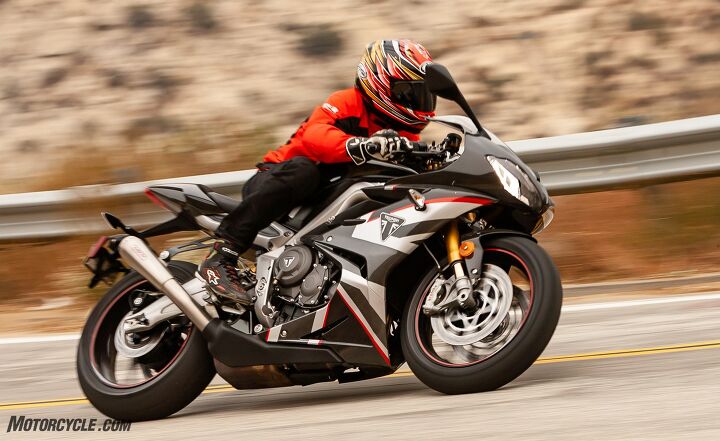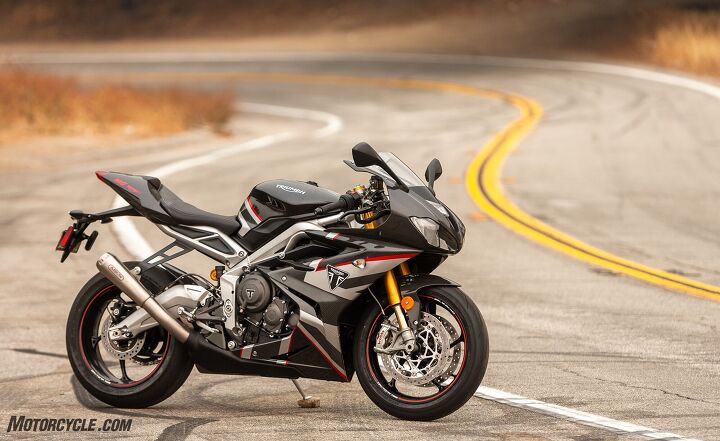When Triumph introduced the Daytona 675, it became popular for a number of reasons but primarily because it was different. While the rest of the supersport category relied on four cylinders and 599cc, Triumph ditched a cylinder and made the remaining three spit out 675cc of air. It made a wonderful sound unlike anything else in the class, it was narrow, it handled well, and the power was impressive.
VIDEO
I’m guessing people mainly gravitated towards the bike for the sound, but at the time of its release, supersport racing was a big deal around the world. Racing success was mixed, but nonetheless the Daytona has carried with it a cult-like following.
Which is why Triumph’s announcement, at the end of 2018, that it would be supplying the Moto2 class with a new 765cc three-cylinder engine from 2019 onwards, replacing the 599cc Four based on the Honda CBR600RR, got myself (and I’m sure many others) really excited. Surely this meant an updated Daytona road bike was in the works.
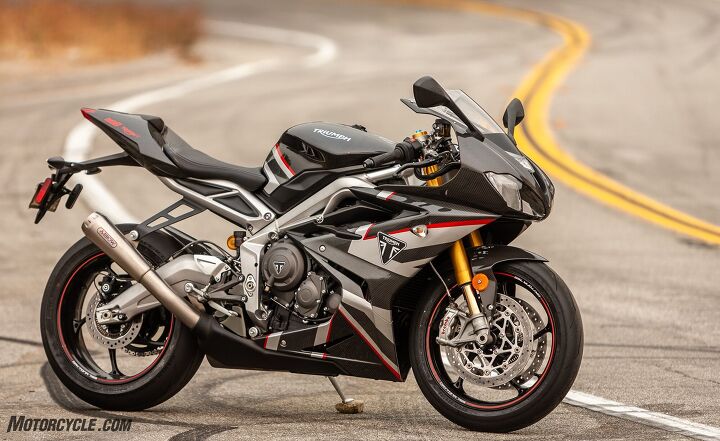
Triumph’s Daytona Moto2 765 is the successor to the previous 675 more people should be excited about. It’s too bad it’s being produced in such limited numbers.
Well, not exactly
Triumph basically went silent on updated Daytona announcements, releasing instead an updated Street Triple 765 that, while fun, wasn’t a Daytona. The big announcement came with this, the Daytona Moto2 765, a co-branded effort with Dorna to promote the Moto2 connection. It’s a limited edition model, with only 1,530 models being made – 765, or half of them, coming to North America, while the rest get spread out over Europe.
Naturally, imaginations went wild dreaming about what this new Daytona would bring to the table. The 765cc Triple was obvious, but with the Moto2 connection what else was there? New frame and swingarm? Big brakes? Cutting edge electronics? This is the usual chain of events when there’s a new model. But this is also where things get a little weird.

The obvious main difference between old and new Daytonas is the bigger 765cc three-cylinder engine. However, if the frame looks familiar to you previous-generation 675 owners, that’s because it’s the same as before. Note the carbon fiber bodywork for weight savings.
First, let’s go over the cool bits, and it all starts at the engine. It’s 765cc displacement puts it squarely in that engine-size sweet spot bikes like the Suzuki GSX-R750 used to occupy (well, technically it still does, I suppose). Its oversquare nature sees a 78 mm bore, 53.38 mm stroke, four valves per cylinder, two overhead cams, and a 12.9:1 compression ratio. Triumph says it’s the highest-performing version of the new Triple, pumping out a claimed 128 hp at the crank and 59 lb-ft of torque.
From there, the Daytona gets another big step up with the Öhlins suspension upgrades front and rear, with the NIX30 fork and TTX36 shock, both of which are obviously fully adjustable. Brembo steps up to the plate next with its latest-generation Stylema calipers, its extra ventilation channel supposedly provides a significant boost in airflow to the pads to help keep them from overheating. Steel-braided lines are a given, but feeding those lines fluid is another Brembo masterpiece, the 19/21 MCS master cylinder. The adjustable ratio of the lever helps fine tune the feel and responsiveness of the brakes to suit rider preferences.

Premium Öhlins components at both ends ensure proper handling and a wide range of adjustments. You’ll also see the subtle Moto2 co-branding, along with the limited edition numbering on top of the triple clamp. It’s a little confusing as technically there will be two Daytona Moto2 765s somewhere on the globe with the same number out of 765. Triumph is making one set for North America while the rest will spread out throughout Europe.
Rounding out the limited edition niceties are Triumph’s Shift-Assist quickshifter that works in both directions, Pirelli Supercorsa SP tires as standard, and the full-color TFT screen with multi-function joystick seen across some of the brand’s other models.
The new bike is also lighter than the previous 675 Daytona, thanks to carbon fiber bodywork, a solo seat (meaning passenger accommodations are gone), and the switch to ride-by-wire – a first for the Daytona line. Triumph claims a dry weight of 363 pounds, which really means nothing since nobody rides a dry motorcycle.

Simply put, the Brembo 19/21 MCS master cylinder is one of the best out there. The adjustable lever ratio will suit braking preferences for virtually any rider.
This all sounds well and good, and it is. However, here’s the odd bit – it’s still the same frame and swingarm as before, only now with a clear anodizing coat. I suppose this isn’t necessarily a bad thing, but for a new model – especially one featuring an engine that’s 113% bigger than before – am I the only one who thinks Triumph missed something by keeping the same frame as the 675R predecessor?
Enough whining. More riding.
Considering the Moto2 connection, it was only natural to bring the Daytona 765 straight to the racetrack. Buttonwillow Raceway, to be exact. Shod with Metzeler’s cool new Racetec TD slicks, after a lap the tires felt like they were ready to attack. For anyone used to the old 675, the 765 will feel instantly familiar. Ergos don’t really feel all too different, and its narrow waistline makes the bike feel very slim.
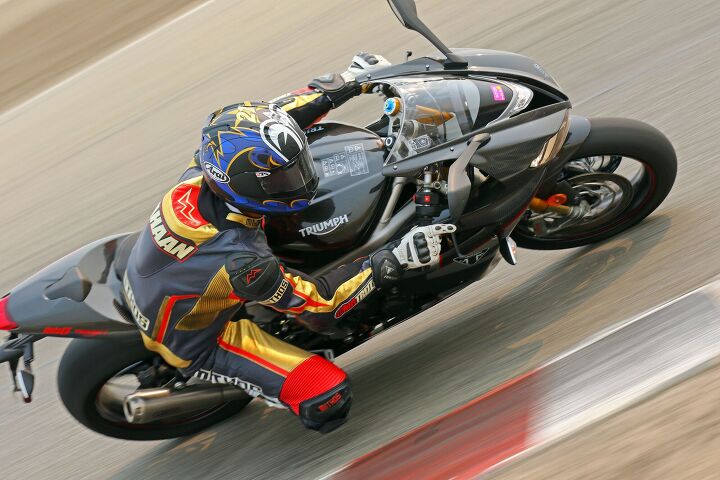
Shout out to Metzeler for providing the Racetec TD slicks for our trackday at Buttonwillow Raceway with Let’s Ride Trackdays. Having a slick tire specifically designed NOT to need tire warmers is a game changer for trackday riders everywhere.
The biggest difference, of course, is the extra power hit from the 765cc Triple. It’s not a massive difference but a noticeable one, nonetheless – like someone spent a lot of time (and money) modifying their 675 with the usual performance mods one does to sportbikes. The gains are everywhere, but you especially feel the extra jolt down low and in the midrange as you pick the bike up and drive out of corners. The top end does feel beefier than its smaller-engined predecessor, as you would expect, but not enormously so. What I was expecting was more high-rpm overrun, but what happens instead is a sudden meeting with the rev limiter.
This in turn gets you instantly familiar with the Triumph Shift Assist (TSA) because you’ll be using it often. Maybe I’ve gotten a bit lazy after riding big literbikes lately, but clicking off shifts on the 765 happens often. Full-throttle upshifts with the quickshifter are especially nice exiting Buttonwillow’s Turn 2, an increasing-radius right turn that has you accelerating while still hanging off the right side of the bike. Using TSA means you don’t have to worry about your hand being awkwardly placed to blip during an upshift. Meanwhile your left toe is reaching to get under the shifter to pop up another gear (this is where a reverse shift pattern comes in handy, but that’s a topic for another time).

The Triumph Shift Assist (aka quickshifter or autoblipper) is generally seen as a net positive, but during our time at the racetrack it fumbled a few times.
Maybe it’s because our particular test bike – number 446 of 765 headed to North America – had less than 500 miles on the clock or perhaps the calibration needs a little more fine tuning, but once the pace picked up, the Shift Assist had trouble keeping up. Both upshifts and downshifts were incredibly hard to engage or missed altogether, so much so that I eventually resorted to shifting the old-fashioned way, feathering off the throttle a smidge on upshifts and using the clutch on downshifts. I’m not so quick to write off the technology since it’s used successfully on other bikes. So, I’ll chalk it up to the freshness of our particular tester.
Otherwise, the slim and narrow stature of the Daytona, combined with its sharp 23.2º rake and short 3.6 inches of trail, make for a fun bike to toss around at will. It steers quickly and confidently, even on the brakes. Some might prefer the stability that comes with a little more trail, but I quite liked the agile nature of the Daytona – so much so that I kinda understand why Triumph decided to leave the previous-generation 675 frame and swingarm alone. If it ain’t broke, don’t fix it.
No surprise here, but the Öhlins bits left nothing to be desired during our time on track, as the bump absorption and feedback from both ends were what you expect from the Swedish brand. The TTX shock was especially nice as the rebound and compression adjusters are controlled via clickable dials that are easily manipulated with gloved hands, making quick adjustments just that – quick.
So far things have looked pretty rosy for the Daytona 765, but I keep coming back to some questionable decisions on Triumph’s part. First, I wonder why Triumph would keep the frame and swingarm from before, only to realize it wasn’t much of a problem. Now, I’m questioning why, on such a premium motorcycle, Triumph would partner top-shelf Brembo Stylema calipers and a MCS master cylinder with 310mm rotors.
The reality is that most people won’t have a problem with this setup, as the master cylinder and caliper combo provide spectacular stopping power, feel, and modulation. But for those who are really going to push the pace on a Daytona 765, the smaller discs (the Yamaha R6 uses 320mm discs, for example) could be prone to overheating and fade. Maybe I’m thinking too much about this. Maybe someone who really does plan on pushing it on one of these will simply upgrade the brake components anyway. Maybe you’ll be just fine.
Nonetheless, my critiques continue. This time it’s with the electronics. Specifically ABS and traction control. First the good: the full-color TFT display is really quite nice and legible, and sorting through the menus with the different buttons and joystick becomes pretty simple once you get used to it.

Ride-mode dependent traction control is a weird move here. But at least you can turn it off entirely if you want.
Here’s where things get weird. ABS is always on, which, really, wasn’t as much of a hindrance as I thought it would be. When in Track mode (one of the five different ride modes available, the others being Road, Rain, Sport, and Rider, a customizable setting) the settings for ABS weren’t nearly as intrusive as I thought they would be. Still, not being able to reduce ABS further or turn it off entirely for track use is annoying. I blame Euro5 regs for that.
The really annoying bit is TC. While it operates at different levels of intervention, depending on the ride mode, the user can’t adjust the level independently. It’s either on or off. Unlike ABS, which I was pleasantly surprised with, this rigidity with TC settings was a surprise that definitely wasn’t pleasant. Even in track mode I’d occasionally see the TC light flashing on the dash when I didn’t think it needed to be intervening, like exiting a corner, getting on the fat part of the tire, and accelerating. I want a little bit of spin to help point the bike where I want it, and with fresh, slick tires a sudden loss of grip wasn’t a concern of mine.
What about on the street?
After digesting the diatribe above, the Daytona 765 really (and oddly, considering the Moto2 connection) redeems itself on the street. As much as I’m not a fan of sportbikes as streetbikes, if you insist on doing it, there are definitely much worse options than the Daytona 765.
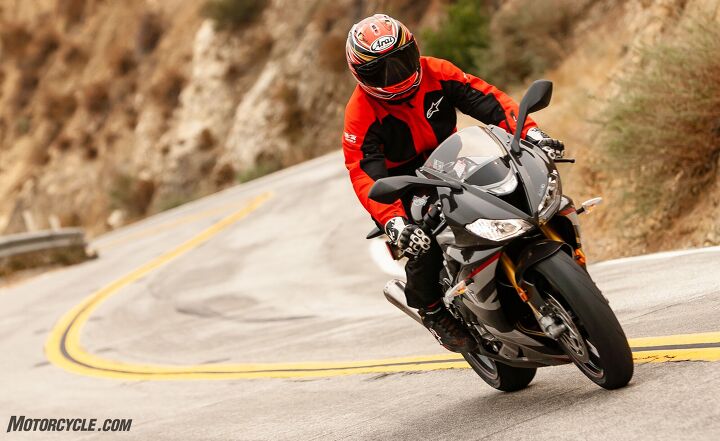
Generally not a fan of sportbikes on the street, mainly because of this riding position. However, if you insist, the Daytona 765 is relatively comfortable.
Sportbike ergonomics don’t favor tooling about on public roads – that’s why naked bikes exist, and in this case, the Street Triple 765, specifically. Then again, it’s hard to deny sportbikes, including the Daytona 765, are beautiful creatures to look at. So if you insist on riding a sportbike on the roads, the D765 actually isn’t too bad. The bars aren’t terribly low (for sportbike standards), nor is the knee bend too dramatic for my 30-inch inseam. With 4.6 gallons of fuel onboard, you could likely go a decent distance before looking for a gas station, too. Not that I’d want to, personally.
With the greater bottom-end and mid-range power, the 765 engine is excellent on the street. Trips to the upper limits of the rev range are few and far between during normal street riding, and the extra boost down low and in the middle means you can carry gears longer and not fret about shifting as much as you would on the track. The lower pace also means the shifting issues I experienced on track with the Shift Assist quickshifter aren’t really issues at all.
Once you get to the fun roads, the chassis will reward you with a quick and nimble performer, though the suspension’s track focus does skew it a little stiff for street riding. Adjusting the clickers on the fly helped in our case, but a preload adjustment tool wasn’t something I had within easy reach.
Again, the lower pace also means the brakes are more than up to the task, and though the bike has five ride mode settings, I never felt the need to bump down to the lower ones. Power comes on smoothly and controllably, and it didn’t feel like any of the nannies were intervening.
Sure the easy solution would be a Street Triple, but it’s slightly down on power compared to the Daytona – if you care about such things. The reality is that the Street Triple is likely the better all-around bike, but the Daytona is a thrill. And it’s gorgeous.
Price
And…it’s also expensive. Starting at $17,500, you really have to love what the Daytona Moto2 765 offers. Yes, it’s a fun package. Yes, it looks great. And yes, you’ll be a part of an exclusive club with 764 other people in North America. But that amount of scratch can go a long way in the middleweight category – or even the liter-class ranks.
Price aside, I do like the Daytona 765. It’s a fun motorcycle I wish Triumph would produce in greater numbers, even if it does mean using lower-spec components to bring the price down. Just as I’m fond of the Suzuki GSX-R750 (and other dearly departed 750s) for its (now) unique place in the sportbike world, the Daytona 765 lies in the goldilocks zone that provides a thrill without scaring the daylights out of you.
A real head scratcher, this one…
If anything my issue is this: with a name like Daytona Moto2 765, the co-branding with Dorna, and with the clear connection to racing – I expected something more. Like a radical new middleweight race bike with lights. Instead, we get a warmed-over version of the previous bike, which wouldn’t be so bad had it not been marketed with this air of exclusivity. Come into it with the right expectations – more like the ultimate Daytona 675 instead of a Moto2-inspired Daytona 765 – and the cost outlay could seem reasonable.
| 2020 Triumph Daytona Moto2 765 | |
+ Highs
|
– Sighs
|
|
In Gear (Track)
|
|
In Gear (Street)
|
| 2020 Triumph Daytona Moto2 765 Specifications | |
|---|---|
| Engine Type | Liquid-cooled, 12 valve, DOHC, in-line 3-cylinder |
| Capacity | 765 cc |
| Bore x Stroke | 78 x 53.38 |
| Compression | 12.9:1 |
| Max Power | 118 hp at 12,250 rpm |
| Max Torque | 59.0 lb-ft. at 9,750 rpm |
| System | Multi-point sequential electronic fuel injection with SAI. Electronic throttle control. |
| Exhaust | Stainless steel 3 into 1 exhaust system. Stainless steel underbody primary silencer. Arrow titanium secondary silencer. |
| Final Drive | Chain |
| Clutch | Wet Multiplate |
| Gearbox | 6-speed with Triumph Shift Assist |
| Frame | Aluminum beam twin spar frame, 2 piece high pressure die cast subframe |
| Swingarm | Twin-sided, cast aluminum alloy |
| Front Wheel | Cast aluminum alloy 5-spoke 17 x 3.5 in |
| Rear Wheel | Cast aluminum alloy 5-spoke 17 x 5.5 in |
| Front Tyre | 120/70 ZR17 |
| Rear Tyre | 180/55 ZR17 |
| Front Suspension | Öhlins 43 mm upside down NIX30 forks with adjustable preload, rebound and compression damping |
| Rear Suspension | Öhlins TTX36 twin tube monoshock with piggy back reservoir, adjustable, rebound and compression damping |
| Front Brake | Brembo Stylema 4 piston radial mono-block calipers, Twin 310 mm floating discs, switchable ABS |
| Rear Brake | Brembo single piston calliper, Single 220 mm disc, switchable ABS |
| Width Handlebars | 28.3 inches |
| Height Without Mirrors | 43.5 inches |
| Seat Height | 32.4 inches |
| Wheelbase | 54.36 inches |
| Rake | 23.2° |
| Trail | 3.6 inches |
| Dry Weight | 363 pounds (claimed) |
| Tank Capacity | 17.4L |
| Fuel Consumption | 12.2 mpg (claimed) |






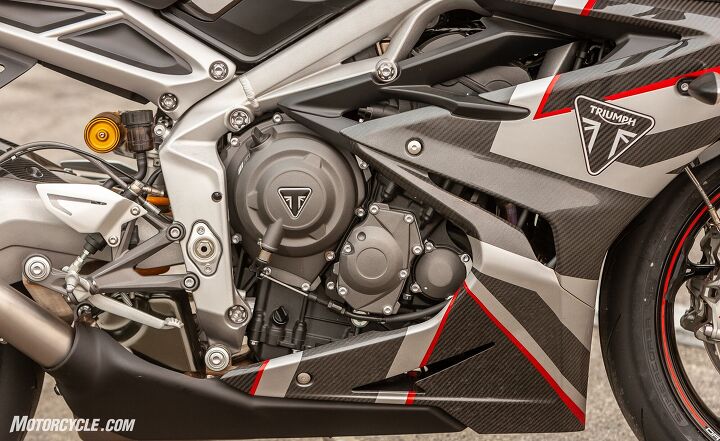


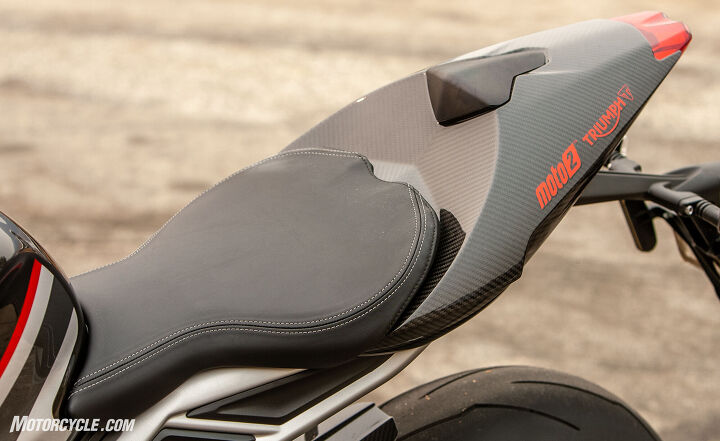
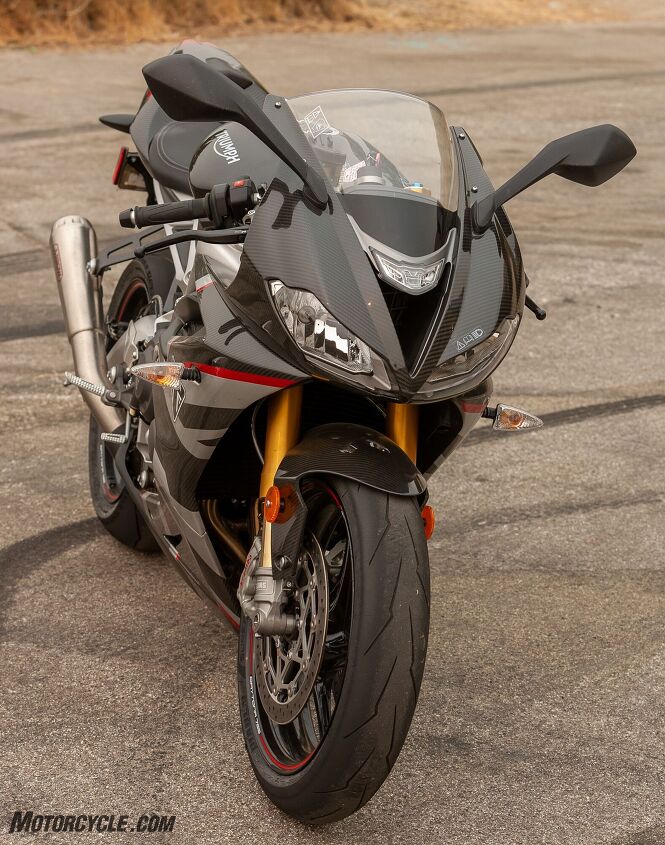








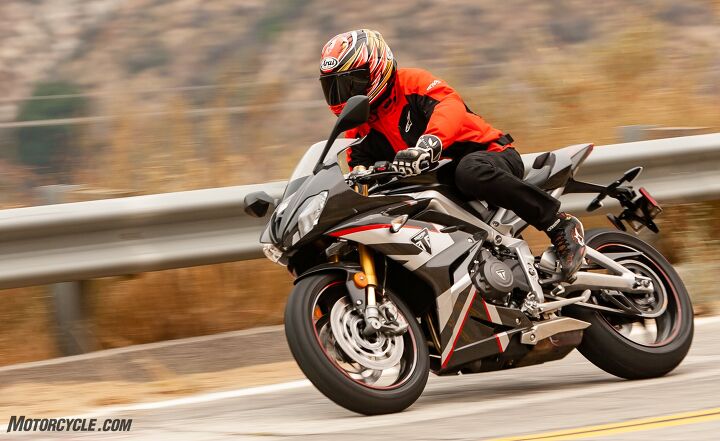
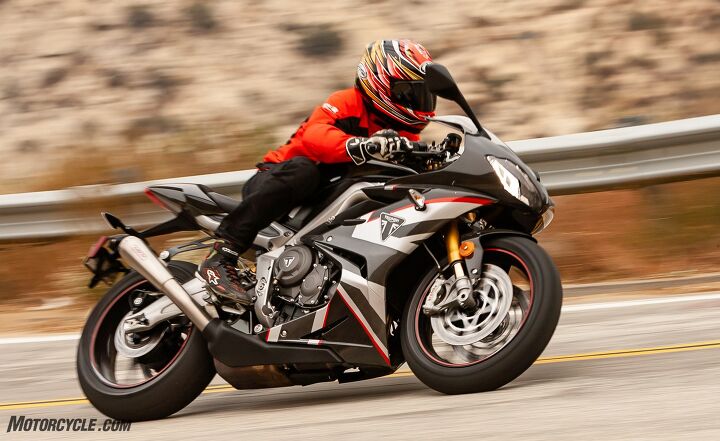







Become a Motorcycle.com insider. Get the latest motorcycle news first by subscribing to our newsletter here.
We are committed to finding, researching, and recommending the best products. We earn commissions from purchases you make using the retail links in our product reviews. Learn more about how this works.
The post 2020 Triumph Daytona Moto2 765 Review appeared first on Motorcycle.com.
【Top 10 Malaysia & Singapore Most Beautiful Girls】Have you follow?


